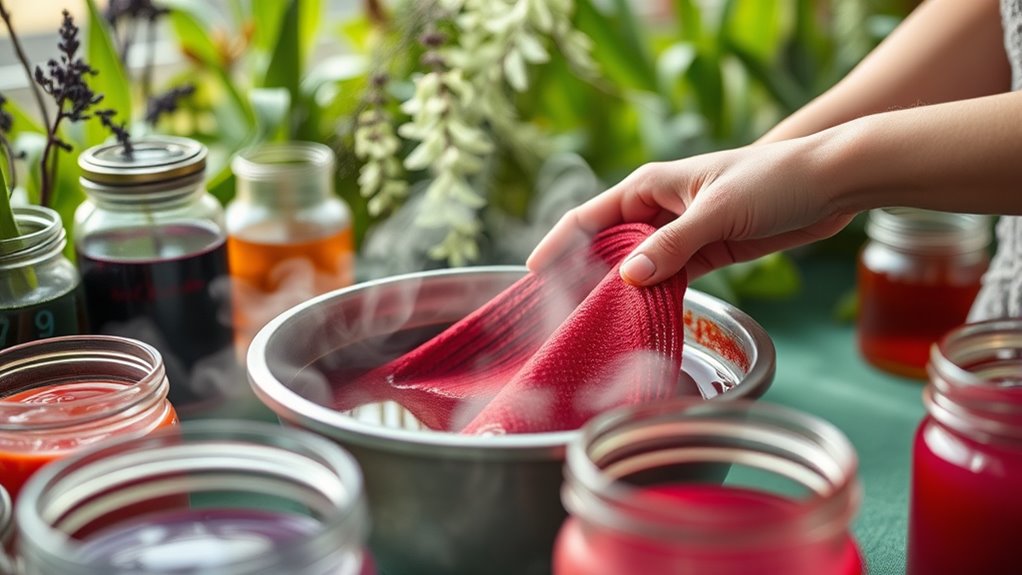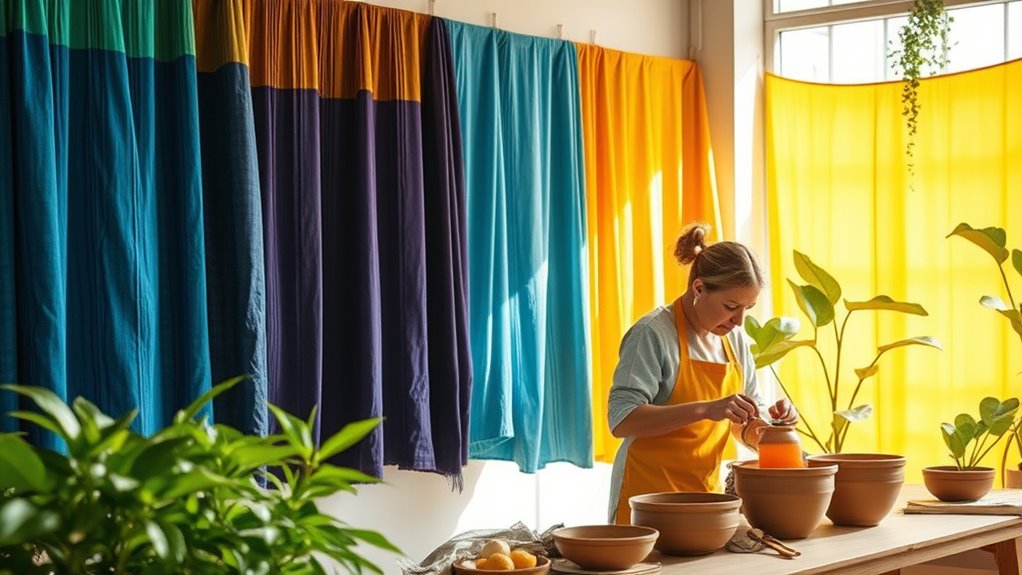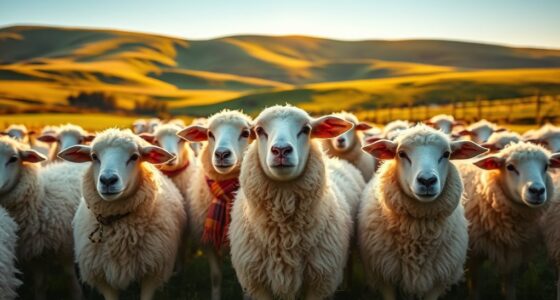Eco-friendly dyes help you cut water use and reduce chemical waste in textile coloring. They bond better with fabrics, so you need less dye and minimize rinsing, which saves water and decreases pollution. These dyes are made from natural, renewable ingredients that break down easily, making production safer for workers and ecosystems. By choosing sustainable options, you support greener practices—if you want to discover more ways to make coloring more eco-friendly, keep exploring.
Key Takeaways
- Eco-friendly dyes utilize natural, biodegradable ingredients that break down easily, reducing long-term environmental pollution.
- These dyes bond more efficiently with fabrics, decreasing water consumption and the need for extensive rinsing during textile processing.
- They contain fewer hazardous chemicals, promoting safer handling for workers and minimizing toxic wastewater discharge.
- Sustainable sourcing of raw materials ensures responsible harvest practices, supporting ecological balance and reducing habitat destruction.
- Adoption of eco-dyes encourages greener textile production, conserving water, reducing chemical use, and lowering the industry’s environmental footprint.

Have you ever wondered if there’s a better way to color fabrics without harming the environment? Traditional dyeing methods often rely on synthetic chemicals and large amounts of water, which can lead to pollution and waste. Eco-friendly dyes present a compelling alternative, offering a way to produce vibrant textiles while minimizing environmental impact. One of their key advantages is their biodegradability benefits, meaning they break down naturally after disposal, reducing long-term pollution. When you choose eco-friendly dyes, you’re supporting sustainable sourcing—using natural, renewable ingredients that are harvested responsibly. This approach ensures that the raw materials for dyes don’t deplete ecosystems or cause habitat destruction, aligning with principles of eco-conscious consumption.
Using eco-friendly dyes helps cut down on water use considerably. Traditional dyeing processes often require hundreds of liters of water per kilogram of fabric, much of which ends up as wastewater loaded with toxic chemicals. Eco-friendly dyes, on the other hand, typically need less water to achieve the same color intensity. Some dyes are designed to bond more efficiently with fibers, reducing the need for repeated dye baths or excessive rinsing. This not only conserves water but also diminishes the amount of contaminated effluent generated. When you opt for these dyes, you’re actively reducing water pollution and conserving this essential resource, making your textile choices more sustainable.
Another benefit of eco-friendly dyes lies in their reduced chemical footprint. Conventional dyes often contain hazardous substances that can harm workers in dyeing facilities and pollute nearby water bodies. Eco-friendly dyes are formulated with safer, often plant-based ingredients, which means fewer harmful chemicals are released into the environment. This safer profile benefits everyone involved in the production process and downstream ecosystems. Furthermore, many eco-friendly dyes are derived from sustainably sourced raw materials, ensuring that the ingredients are obtained in a way that respects ecological balance and supports fair trade practices. By selecting dyes with sustainable sourcing, you’re contributing to a cycle that promotes environmental health and social responsibility.
Incorporating eco-friendly dyes into your textile choices isn’t just about reducing environmental harm; it’s about making a statement that sustainability matters. It means supporting innovations that use biodegradable ingredients, lessen water and chemical consumption, and prioritize responsible sourcing. These dyes allow you to enjoy vibrant fabrics while actively participating in a greener, more sustainable future. So next time you’re shopping for textiles or considering a DIY project, think about the benefits of eco-friendly dyes—they’re better for the planet, safer for producers, and just as beautiful in the end.
Frequently Asked Questions
How Do Eco-Friendly Dyes Compare in Cost to Traditional Dyes?
Eco-friendly dyes generally cost more upfront than traditional dyes, but their cost comparison varies depending on factors like sourcing and scale. You might find the initial investment higher, yet their economic feasibility improves over time thanks to lower water, chemical, and energy expenses. If you’re considering sustainability, weigh these benefits against the higher initial costs, as eco-friendly dyes can be a cost-effective choice long-term, especially with increasing demand for greener practices.
Are Eco-Friendly Dyes Suitable for All Types of Textiles?
Think of eco-friendly dyes as versatile brushes, adapting to different textile canvases. They suit many fibers, but fiber compatibility and dye absorption make certain outcomes more likely. Natural fibers like cotton and wool often absorb eco-dyes beautifully, while synthetic fibers may need special treatment. You’ll find that eco-dyes can work across a range of textiles, but understanding each fiber’s unique qualities ensures vibrant, lasting colors. Your choice depends on matching dye properties with fabric needs.
What Are the Challenges in Scaling Eco-Friendly Dye Production?
You’ll face challenges in scaling eco-friendly dye production due to supply chain issues and technological limitations. These dyes often require specialized raw materials and processes, making it harder to source consistently. Additionally, current technology may not fully support large-scale manufacturing efficiently or cost-effectively. To overcome these hurdles, you need to invest in research, develop sustainable supply networks, and improve processing techniques to make eco-friendly dyes more accessible and scalable.
Do Eco-Friendly Dyes Affect the Durability of the Fabric?
Eco-friendly dyes generally don’t compromise fabric longevity or colorfastness when properly formulated. You’ll find that fabrics dyed with sustainable options often maintain their durability and vibrant colors over time, just like traditional dyes. However, it’s crucial to verify that the specific eco-friendly dye used is compatible with your fabric type and application process. When chosen correctly, eco-friendly dyes support long-lasting, vibrant textiles without sacrificing quality.
How Long Does the Coloring Process Take With Eco-Friendly Dyes?
Imagine planting a seed and watching it sprout faster than expected—that’s how eco-friendly dyeing compares. The dyeing duration with these dyes typically takes about the same time as traditional methods, around 1-3 hours, thanks to process efficiency. While some may worry about longer times, the eco benefits often outweigh this. You’ll find that eco-friendly dyeing fits smoothly into your schedule, offering sustainable results without sacrificing time.
Conclusion
By choosing eco-friendly dyes, you’re not just coloring fabrics—you’re painting a greener future. Think of these dyes as the gentle rain nourishing a thirsty garden, revitalizing the textile industry while saving water and chemicals. Every small step you take toward sustainable coloring adds up, transforming the industry from a polluting beast into a blooming meadow. So, embrace these dyes and be the spark that turns the tide toward a cleaner, brighter planet.









